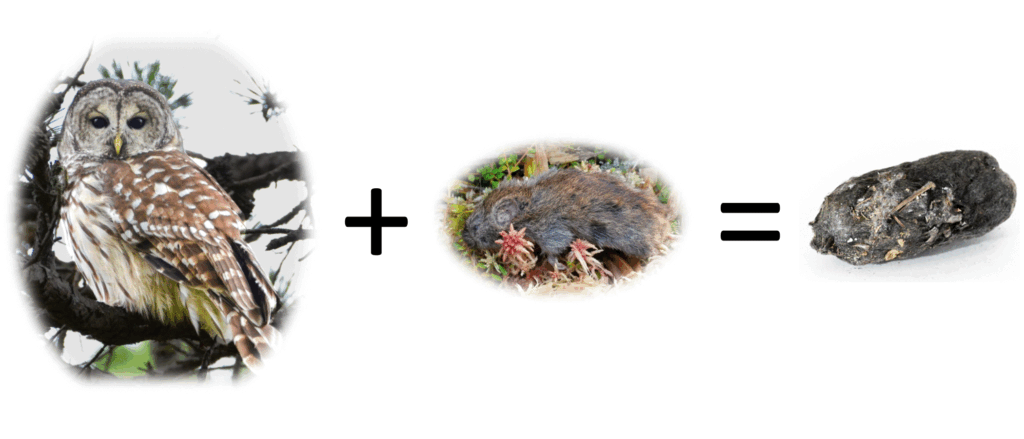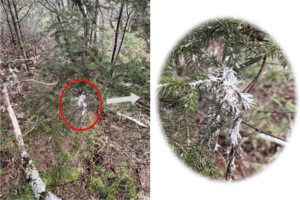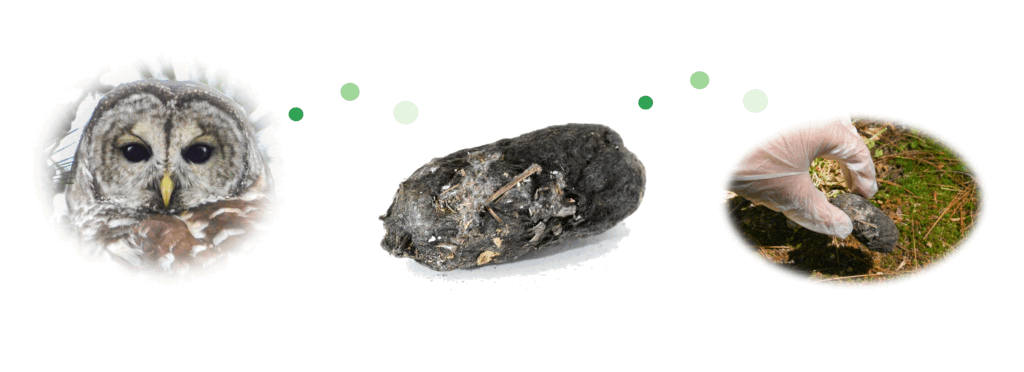
How to find an owl pellet
Setting out to find an owl pellet can feel like searching for a needle in a haystack, but learning more about owl pellets, what they look like, and where they are commonly located can increase your chances of success.
-
- Owls eat their prey whole but are not able to digest hard parts like bones, fur, or feathers.
- These indigestible parts are retained in an area of the owl’s digestive tract called the gizzard, which also typically contains small pebbles or grains of sand that help with digestion. After a meal, when the owl has digested as much of its prey as it can, the indigestible parts in the gizzard form into a pellet and are coughed up by the owl.
- These indigestible parts are retained in an area of the owl’s digestive tract called the gizzard, which also typically contains small pebbles or grains of sand that help with digestion. After a meal, when the owl has digested as much of its prey as it can, the indigestible parts in the gizzard form into a pellet and are coughed up by the owl.
- Owl pellets are usually brownish/grayish, oblong lumps that vary in size from about 1–3” long.
- Because they are composed primarily of indigestible prey remains, their appearance varies based on the owl’s last meal. Owls eat a lot of rodents, so many owl pellets look like a lump of hair and bones. Owl pellets can also include feathers, pieces of insects or crayfish exoskeleton, and other prey items, and may also contain sand or pebbles from the gizzard. Check out our image gallery to see examples! The Barn Owl Trust in the UK is a fantastic resource for learning more about owl pellets.
- Other animals produce pellets or scat that can resemble an owl pellet.
- As a general rule, if you find something that looks like a pellet but that has visible blood, organs, or other undigested tissue, please don’t send it in. The same goes for anything that resembles or smells like animal scat. If you are not sure whether you have found a pellet, leave the object in place and email us a picture at owlpellets@une.edu.
- Knowing how to identify an owl pellet is a good starting point but understanding a little bit more about owl behavior increases the chances of finding one.
- When they’re not out hunting, owls typically hunker down in a roost. Roosts vary with owl species: some owls use cavities, others use dense stands of trees, and others yet roost on the ground or in man-made structures. Because owls are often very well camouflaged, it can be hard to find their roosts; however, one giveaway is the presence of “whitewash” (i.e., owl excrement) at the base of a tree. Whitewash simply looks like spilled white paint on a tree trunk, branch, or on the ground. It can be mistaken for pine resin, which is also white but is typically sticky and fragrant. If you find a tree with whitewash at its base, odds are that you’ll also find owl pellets nearby!

- When they’re not out hunting, owls typically hunker down in a roost. Roosts vary with owl species: some owls use cavities, others use dense stands of trees, and others yet roost on the ground or in man-made structures. Because owls are often very well camouflaged, it can be hard to find their roosts; however, one giveaway is the presence of “whitewash” (i.e., owl excrement) at the base of a tree. Whitewash simply looks like spilled white paint on a tree trunk, branch, or on the ground. It can be mistaken for pine resin, which is also white but is typically sticky and fragrant. If you find a tree with whitewash at its base, odds are that you’ll also find owl pellets nearby!
- Owls eat their prey whole but are not able to digest hard parts like bones, fur, or feathers.
-
- Owl pellets may be found in unexpected places.
- For example, one of our team members found an owl pellet on the branches of a tree at a Christmas tree farm. We recommend keeping an eye out for pellets any time you are out enjoying nature!
- The wellbeing of owls takes precedence over our project.
- Before you set out to search for owl pellets, we recommend reviewing the American Birding Association’s Code of Birding Ethics (https://www.aba.org/aba-code-of-birding-ethics/) to ensure that you will not cause stress to any owls. Please also be sure to follow all local laws and guidelines to ensure your own safety.
- Owl pellets may be found in unexpected places.
How to collect the pellet
1) Document the pellet and location before you collect it
- Take some photos, if possible.
- Before picking up the pellet, use your phone or camera to take a photo of it and of the immediate surroundings. These photos can be included with your submission form entry and may provide clues to the team about the owl species that produced it and other data.
- Before picking up the pellet, use your phone or camera to take a photo of it and of the immediate surroundings. These photos can be included with your submission form entry and may provide clues to the team about the owl species that produced it and other data.
- Note the pellet location.
- It is important that you provide an accurate location where the owl pellet was found. This can be accomplished in several different ways:
- Our submission form can access your phone’s GPS to get an accurate location.
- You may be able to use a navigation or compass app in your phone to obtain GPS coordinates of your location.
- You can create a waypoint with a handheld GPS unit.
- Or, you can mark your location on a map or take detailed notes of your surroundings so that you can determine your location later.
- It is important that you provide an accurate location where the owl pellet was found. This can be accomplished in several different ways:
2) Collect the pellet. To minimize risk associated with handling owl pellets, please 1) flip a ziplock baggie over your hand (like a dog waste bag) to collect the pellet, then 2) seal the baggie and keep it away from food and drink.
- Owl pellets, like all animal products, can carry pathogens that can be harmful to humans.*
- To minimize risk associated with handling owl pellets, please:
- Flip a ziplock baggie over your hand (like a dog waste bag) to collect the pellet. Seal the baggie and keep it away from food and drink.
- After collecting the pellet, wash your hands with water and soap or alcohol soap
*Owl pellets probably contain a variety of common enteric bacteria such as E. coli, Salmonella spp., and Listeria spp. that can be pathogenic (Dipineto et al. 2015), and may contain bacterial pathogens such as Campylobacter spp., Erysipelothrix rhusiopathiae, Pasteurella multocida, and Yersinia pseudotuberculosis, fungal pathogens such as Histoplasma capsulatum, along with viruses like Hantavirus and those that cause avian influenza and Newcastle disease among others. For example, public health officials reported a Salmonella outbreak in elementary-aged children after owl pellets were handled on surfaces without proper sanitation measures (Smith et al. 2005).
Literature Cited:
Dipineto, L., Bossa, L. M. D. L., Pace, A., Russo, T. P., Gargiulo, A., Ciccarelli, F., Raia, P., Caputo, V., & Fioretti, A. (2015). Microbiological survey of birds of prey pellets. Comparative Immunology, Microbiology and Infectious Diseases, 41, 49-53.
Smith, K. E., Anderson, F., Medus, C., Leano, F., & Adams, J. (2005). Outbreaks of salmonellosis at elementary schools associated with dissection of owl pellets. Vector-Borne & Zoonotic Diseases, 5(2), 133-136.
3) Complete the submission form, saving your submission ID
- Before mailing us your pellet, please take a few minutes to complete the Maine Owl Pellet Project submission form.
- This form will instruct you on how to create a unique submission ID that will help us tie the information you provide back to your pellet once it arrives and is processed.
- Write your submission ID on a slip of paper – you’ll include that in the envelope with your pellet.
- Once we process your pellet and identify its contents, we will use this same submission ID to post results on our website, so be sure to write down your submission ID and check back often!
How to send us the pellet
4) Place the owl pellet and a slip of paper with your submission ID into an envelope, and put it in the mail
- Address the envelope to:
Maine Owl Pellet Project
c/o Dr. Zach Olson
University of New England
11 Hills Beach Rd.
Biddeford, ME 04005
- Apply postage
- Note that mailing an owl pellet will require 2 first class stamps (~$1.20) to ensure delivery.
- If you’d like us to send you a self-addressed envelope with postage pre-paid, please reach out via email to owlpellets@une.edu. A project team member will get back to you within about a week depending on the volume of incoming requests.


